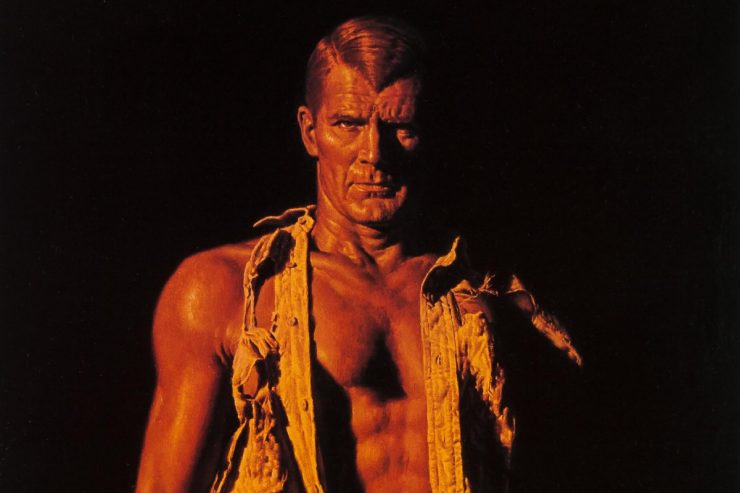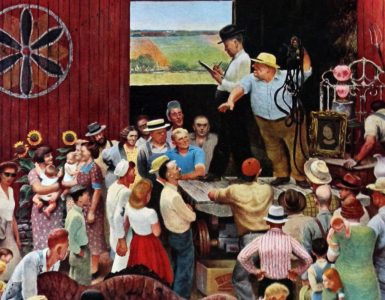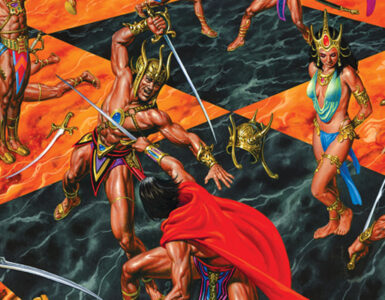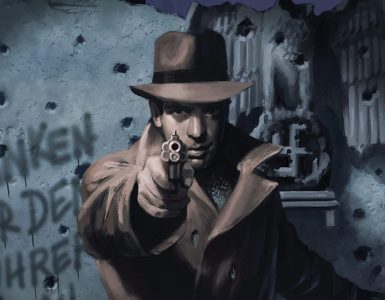Pulp magazines have influenced writers, artists, film directors, software developers, and countless others over the years. Our “PulpFest Profiles” focus on contemporary creators who have drawn inspiration from these rough-paper fiction magazines.
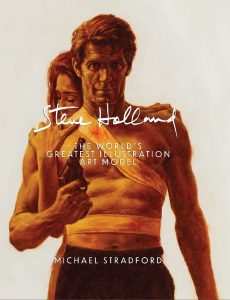
Actor-model Steve Holland was literally a chameleon when it came to embodying the archetypal American White male figure between the 1950s through at least the early 1990s.
For decades, Holland’s image — explicitly and implicitly — was front and center in literally thousands of cover and interior illustrations of paperbacks, men’s adventure magazines, and comic books.
Steve Holland was variously noir crime protagonists and old west avatars. He was myriad comic book heroes including Captain America and Superman. Holland posed as historical figures, as well as crab- and weasel-battling men’s adventure magazine cover icons.
Although Holland apparently never sat for any vintage pulp cover illustrations, Steve Holland has memorably embodied several key pulp magazine heroes — most notably Doc Savage for neo-realist painter James Bama and other illustrators. Their covers were featured on scores of the Bantam paperback Savage reprints.
Holland modeled as The Avenger for artists Peter Caras and George Gross for the Warner Books reprints of the vintage Street & Smith pulps.
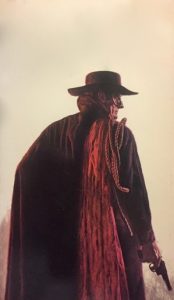 He also served as a reimagined version of The Spider, posing for painter Peter Caras — complete with a domino mask, slouch hat, and cloak — as well as another reimagined version, this time with blonde locks and, (ahem) a turtleneck.
He also served as a reimagined version of The Spider, posing for painter Peter Caras — complete with a domino mask, slouch hat, and cloak — as well as another reimagined version, this time with blonde locks and, (ahem) a turtleneck.
Author Michael Stradford has recently published two striking volumes celebrating Steve Holland.
The first, Steve Holland: The Torn Shirt Sessions, focuses on classic Doc Savage cover illustrations paired with original reference photos of Holland posed as Doc, complete with torn shirt, jodhpurs, and riding boots.
Steve Holland: The World’s Greatest Illustration Model, is a career-spanning survey of Holland’s broad career, rich with interviews including painters, family members, photographers, and fellow models who entered Holland’s orbit.
Michael Stradford first made his indirect acquaintance with Holland when he was drawn to a particular Bantam Doc Savage paperback cover.
“When I first became aware of Steve Holland I wasn’t aware of Steve Holland,” Stradford said. “When I was a kid I saw James Bama’s painted cover for The Giggling Ghost, the Bantam Doc Savage reprint. That got me really interested in the character of Doc Savage, but also, and probably more importantly, James Bama’s interpretation of the character. Over the years, I collected a number of the paperbacks, and I never really understood what I was looking at because I knew it was a painting, but it looked like photography.”
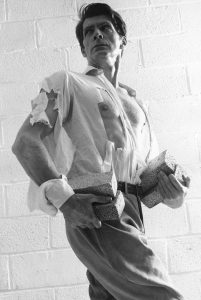
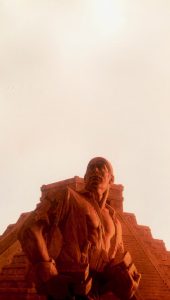
Flash forward:
“Years later — I don’t remember how I found out — I learned that James Bama’s interpretation was based on Steve Holland, the model,” Stradford recalled. “When I found that out, I was just really surprised. I read an article about Holland in Starlog or Comixscene or something. It was interesting. After that, I just kind of filed it away.
“Then I went to the San Diego Comic-Con one year, and Bob Chapman, who owns Graphitti Designs, was selling a number of high-end Doc Savage products including limited lithographs that James Bama had signed. Chapman also had a bronze sculpture that Joe DeVito had signed.
“Bob Chapman is a really nice guy. He and I started having conversations, and one day he mentioned that he would love to collect all of the (Doc Savage) paintings into a book. I said, ‘I think it would be great to do a book but also on the opposite page have the reference photo of Steve Holland.’”
Chapman was intrigued, but cautioned Stradford, “That’s a great idea, but you know the profit margin for the Doc Savage product is really small and I can’t imagine ever doing that.”
At that point, Stradford’s dream of a Doc Savage book pairing Bama’s and others’ paintings with their original reference photos went on the back burner for years, if not decades.
“It just kind of sat dormant for a long time and I didn’t really think about it until years later when I stumbled across Bob Deis’ site, menspulpmags.com (“The Men’s Adventure Magazines & Books Blog”). Then I found Bob’s Facebook page, and he and I started a correspondence when I bought several of his books,” Stradford explained. “I was really interested in the art more so than the stories. He had put out a book on Eva Lynd who was essentially Steve Holland’s female equivalent in the men’s adventure magazine genre. Eva had participated in the book’s creation, and it was really nice.
“I was talking to Bob and said, ‘Years ago, I had an idea about doing a book on Steve Holland and the Doc Savage stuff. Now that I know even more about Steve Holland, and the breadth of his career, it would be really interesting to do a book that kind of covers that.’ Bob was really interested in working on that with me. That was how it started.”
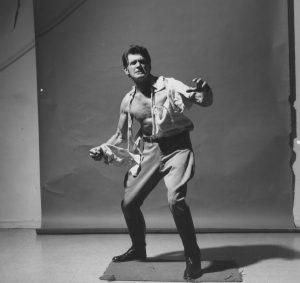 Stradford began interviewing; he amassed paperbacks and reference photos. He recalled, “I’ve got a lot of Doc Savage, I’ve got a lot of the Nevada Jim that Bama did with Holland. The result was The Torn Shirt Sessions.
Stradford began interviewing; he amassed paperbacks and reference photos. He recalled, “I’ve got a lot of Doc Savage, I’ve got a lot of the Nevada Jim that Bama did with Holland. The result was The Torn Shirt Sessions.
“I designed that book myself, which I had never done before. I just kind of put it together and got it out there and it got a really nice response. So I felt emboldened to keep traveling down the trek of doing the complete career overview book which is World’s Greatest Illustration Art Model.”
One of the ironic peculiarities regarding Holland was the fact that he could credibly embody every character from a Louis L’Amour western figure to Doc Savage to the Incredible Hulk. Yet in many of the interviews Stradford collected, several painters and others muse that they never really felt they connected deeply with Holland.
Others felt they had a close connection to Holland, but it wasn’t one the actor-turned-model seemed to share.
Stradford allowed, “It seems like he had the ability to make whoever he was with feel as if they had a deeper and closer relationship than they actually did. In (a filmed) interview he did with Paul Jilbert, he said — this isn’t an exact quote, but it’s close — ‘I don’t think I had a personal relationship with any of those guys.’
“But Bob Larkin and Peter Caras? James Bama? They all talked about their connection to Holland and it was sincere. They all talked about how close they were. You also, I think, have to balance that with the passage of time, and because of where Holland was in his life toward the last few years. It didn’t seem like he was that satisfied or that happy. So he might look at some of that history through a different lens than the other people remember.”
Owing to the passage of time, many of the artists Stradford interviewed were upwards of age 90 when he asked them for their Holland remembrances. Indeed, painter Peter Caras passed away just a few days before this PulpFest interview with Stradford was conducted.
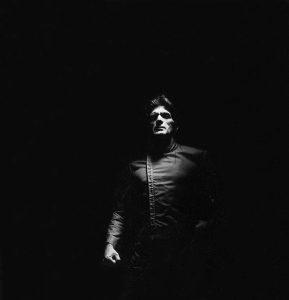 Stradford recalled, “With Caras, it was very interesting. He was one of the first people I talked to and he couldn’t have been nicer. He was a great storyteller. He was very energetic. He sent me all of his reference photos and he apologized that he didn’t have more. He said, ‘I painted over 2,000 covers and several hundred of them were with Steve and I had reference photos for everything. But I didn’t think that stuff was going to mean anything to anybody so I didn’t hold onto it.’ He was great, and even after the interview, we stayed in touch. Sometimes we would get new information, or I’d run across an illustration that looked like it was his, and I would call to see if it was. That would lead to three or four great stories. He was awesome.
Stradford recalled, “With Caras, it was very interesting. He was one of the first people I talked to and he couldn’t have been nicer. He was a great storyteller. He was very energetic. He sent me all of his reference photos and he apologized that he didn’t have more. He said, ‘I painted over 2,000 covers and several hundred of them were with Steve and I had reference photos for everything. But I didn’t think that stuff was going to mean anything to anybody so I didn’t hold onto it.’ He was great, and even after the interview, we stayed in touch. Sometimes we would get new information, or I’d run across an illustration that looked like it was his, and I would call to see if it was. That would lead to three or four great stories. He was awesome.
“I was happy to talk to James Bama who I think at the time was 91,” Stradford continued. “Still lively, a great conversation. Jack Faragasso, was 92 at the time of my interview with him. He’s still busy, with an active social media presence. Many of the people I contacted were more than happy to talk about Steve and had great memories of him.”
If Holland was indeed a kind of distant figure when it came to at least some of his professional relationships, Stradford said it was different with family, particularly Steve’s children.
“It was nice to hear that even though he was married three times, he was a dedicated father,” Stradford said. “He loved his kids a lot. His daughter Nicole was really invaluable in the writing of the book. The things she relayed were really, really impressive. If there was anything that surprised me it was just to your earlier point about how he could be perceived as this charming, well-regarded guy but also had this ability to be somewhat remote. From what I understand – I think it was his last wife, Jean, who told me – he always saw modeling as work, as a job. He didn’t see it as anything special. It was just what he did to make a living and to take care of his family. I guess toward the last four or five years of his life, he went to a couple of Comic-Cons and he was startled and confused — but appreciative — that there were people who knew who he was and who wanted his autograph.”
Coming next is a third Holland volume. According to Stradford, “It’s called Steve Holland: Cowboy. It will be a collection of out-of-print western paperbacks, with some illustrations, text, reference photos, and a few comic book covers. He did a character for a western comic book series where he posed for the colored photographic covers of the ten issues that were published. In this book, there won’t be a lot of text. There’s an introductory page, and then you’re just off into the art and the photos. Then, in the back, there’s an index that cites the illustrators when I know who they were. Unfortunately, a lot of them I didn’t know.” The book should be released during the summer of 2022.
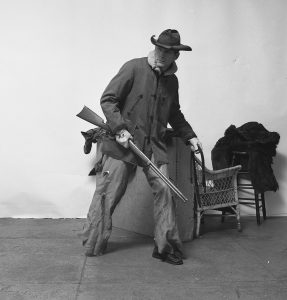 Stradford envisions a fourth and final volume, as well. “What I think will be the last one for the foreseeable future is one called Steve Holland: Paperback Hero. It will be a collection of paperback covers from the different genres in which he was featured: western, adventure, spies, historical, crime, that kind of thing. Then, it will be a wrap for a while. The ceiling is pretty clear in terms of sales with books like this as a self-publisher. So I can’t really afford to do much more than I’ve done, although I’m glad that I’ve done it. I’ve really enjoyed the research part of it and I love finding new material. But I think after that, I’ll probably hit the brakes unless all of a sudden I come across an incredible archive of really good material and get access to some illustrations that I can scan or that have been scanned. That would probably be it.”
Stradford envisions a fourth and final volume, as well. “What I think will be the last one for the foreseeable future is one called Steve Holland: Paperback Hero. It will be a collection of paperback covers from the different genres in which he was featured: western, adventure, spies, historical, crime, that kind of thing. Then, it will be a wrap for a while. The ceiling is pretty clear in terms of sales with books like this as a self-publisher. So I can’t really afford to do much more than I’ve done, although I’m glad that I’ve done it. I’ve really enjoyed the research part of it and I love finding new material. But I think after that, I’ll probably hit the brakes unless all of a sudden I come across an incredible archive of really good material and get access to some illustrations that I can scan or that have been scanned. That would probably be it.”
The Holland books are augmented by a robustly updated blog that sees new posts about twice a week.
As noted, Steve Holland was for years the illustration manifestation of masculinity across a range of fiction and non-fiction genres.
Pondering Holland’s enduring mystique, Stradford observed, “When I think about Holland and the books, I also think about Betty Page. Although they are two different animals, there are some similarities in that they both represented a particular perspective of America. Betty as a woman and Steve as a man.
“But I think that Holland can be a really good lens into how America saw itself over a particular period of time — through the lens of pop culture. When you look at how many different artists saw what he brought as a representation of what they thought that genre was. That kind of speaks to a particular point in America that I find interesting.
“And me, as a Black guy, as an African-American, to have this interest in this White man? It just kind of speaks, I think, to the breadth of Steve Holland’s appeal. Even though he was what he was, his appeal wasn’t restricted by it.”
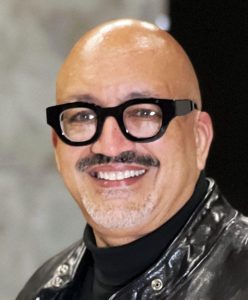 Michael Stradford has worked in the entertainment industry for over three decades. According to The Black Wall Street Times, he began his career as a radio announcer in the Midwest, before taking a former Los Angeles classical music station from a ranking of 33 to number six in less than a year. Music legend Quincy Jones “plucked him from radio” to become vice president of artists and repertoire for Jones’ Qwest Records, a joint venture with Warner Bros. Michael later supervised the DVD special features department for Columbia Home Entertainment before moving over to Sony Pictures Home Entertainment, ultimately overseeing “the creation of original content at Sony-owned online outlet crackle.com.” He is currently Executive Director, Worldwide Content Creation Group at Warner Bros. Pictures.
Michael Stradford has worked in the entertainment industry for over three decades. According to The Black Wall Street Times, he began his career as a radio announcer in the Midwest, before taking a former Los Angeles classical music station from a ranking of 33 to number six in less than a year. Music legend Quincy Jones “plucked him from radio” to become vice president of artists and repertoire for Jones’ Qwest Records, a joint venture with Warner Bros. Michael later supervised the DVD special features department for Columbia Home Entertainment before moving over to Sony Pictures Home Entertainment, ultimately overseeing “the creation of original content at Sony-owned online outlet crackle.com.” He is currently Executive Director, Worldwide Content Creation Group at Warner Bros. Pictures.
In addition to his Steve Holland books, Michael is the author of MilesStyle: The Fashion of Miles Davis and Black to the Movies and Other Pop Culture Musings, and the host of the “Looking for the Cool” podcast on DC Radio.
For more information about Michael’s Steve Holland books, visit stevehollandbook.com/.
The author of the Edgar-nominated Hector Lassiter historical crime series, Craig McDonald is an award-winning novelist, journalist, and editor. His series chronicles the exploits of a fictional Black Mask author and his encounters with such notable figures as Ernest Hemingway, Orson Welles, Ian Fleming, and Lester Dent. In addition to his Edgar nomination, Craig was also a finalist for the Anthony, Gumshoe, and Crimespree Magazine award for best first novel. Craig is also on the PulpFest writing staff and has presented regularly for a number of years at the convention.
Our featured image is James Bama’s original cover painting for The Man of Bronze, first released by Bantam Books in October 1964. Along with Walter M. Baumhofer, James Bama is recognized among the most influential of the Doc Savage artists. Written by Lester Dent, “The Man of Bronze” originally appeared in the March 1933 issue of Street & Smith’s Doc Savage Magazine.
Bama’s depiction of Doc’s hair in his painting was later revised by the artist at the request of Bantam’s art director, Len Leone, to “emphasize the widow’s peak and to try to make it look like it might be made of metal, like some sort of helmet.”
The cover art for Michael Stradford’s Steve Holland: The World’s Greatest Illustration Model is by the late Peter Caras. It was originally used as the cover art for Cry of the Hawk, a “Zach Jones Espionage Thriller” released in January 1970 by Paperback Library. The author was Hy Steirman.
Peter Caras studied at the Art Institute of Pittsburgh and the Art Students League of New York. He was instructed by Frank Reilley, James Bama, and Norman Rockwell. Caras created over 2,000 paperback and magazine covers, including the cover art for Cry of the Hawk. The artist passed away on February 28, 2022.
Peter Caras created the cover art for the paperback edition of The Spider: Wheel of Death, released by Berkley Medallion in November 1969. The novel was written by R. T. M. Scott and originally published in Popular Publications’ The Spider for November 1933.
James Bama’s cover painting for The Golden Peril, released by Bantam Books in December 1970 as the 55th book in their Doc Savage paperback series. The novel was written by Harold A. Davis and Lester Dent (as Kenneth Robeson) and originally published in the December 1937 issue of Street & Smith’s Doc Savage. The reference photo of Steve Holand as Doc Savage was used by Bama to create his painting.
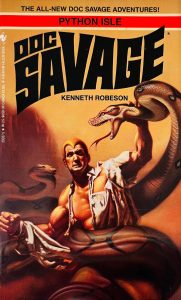 A photograph of Steve Holland, posing as Doc Savage for artist Joe DeVito. Dated January 30, 1991, the photograph features Holland posing for the cover to Python Isle. Co-written by Lester Dent and Will Murray (as Kenneth Robeson), Python Isle was originally released in October 1991 by Bantam Books.
A photograph of Steve Holland, posing as Doc Savage for artist Joe DeVito. Dated January 30, 1991, the photograph features Holland posing for the cover to Python Isle. Co-written by Lester Dent and Will Murray (as Kenneth Robeson), Python Isle was originally released in October 1991 by Bantam Books.
A photograph of Steve Holland, posing for Peter Caras’ cover painting for the paperback edition of The Avenger novel, Justice, Inc., released by Warner Books in June 1972. The novel was written by Paul Ernst (as Kenneth Robeson) and originally published by Street & Smith in The Avenger for September 1939.
A photograph of Steve Holland, posing for James Bama’s cover painting for Louis L’amour’s Down The Long Hills, originally published by Bantam Books in 1968. L’amour’s novel won the Spur Award for Best Western Novel of 1968. The novel was adapted for television in 1986 as a film starring Bruce Boxleitner, Bo Hopkins, and Michael Wren.
A recent headshot of Michael Stradford.

